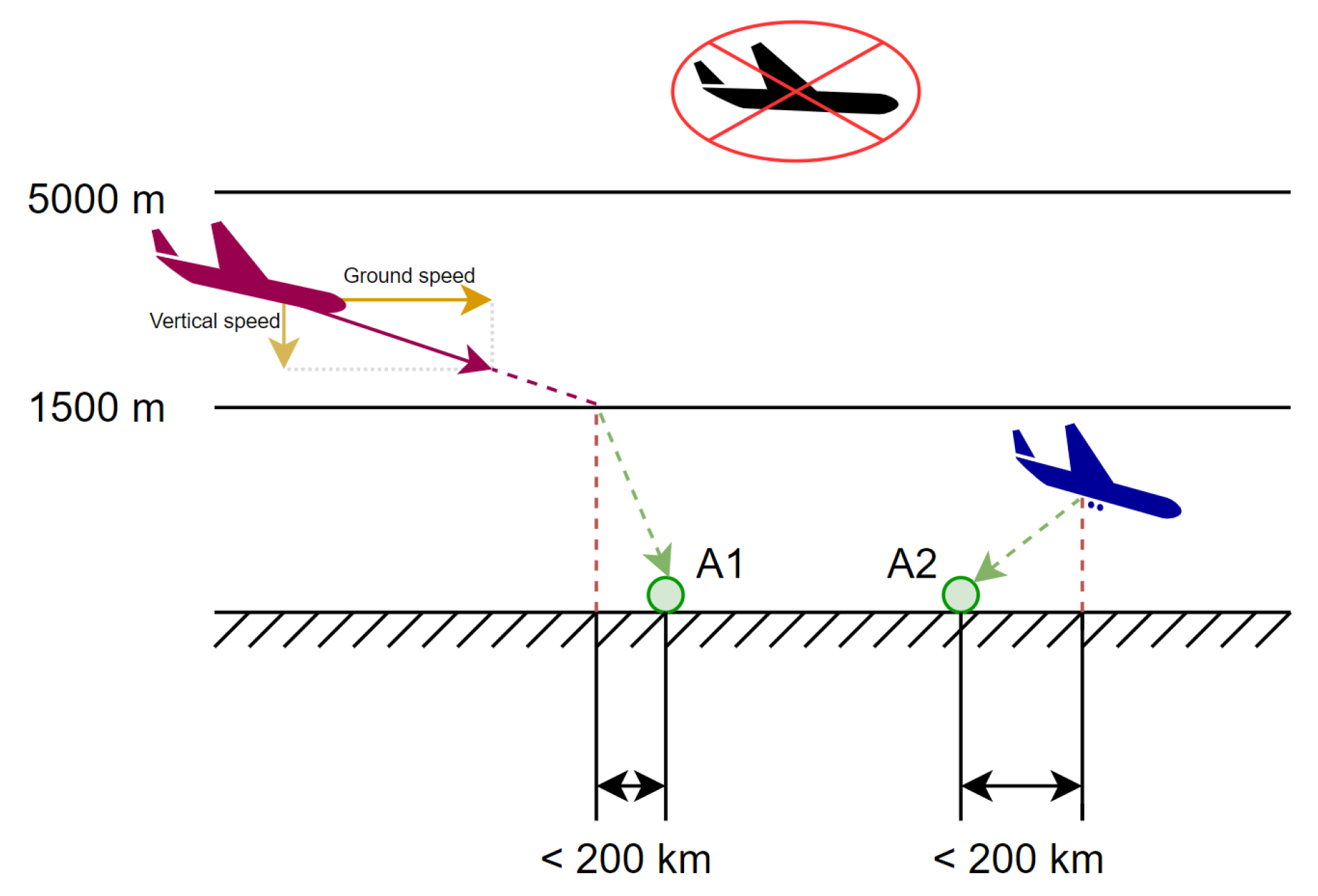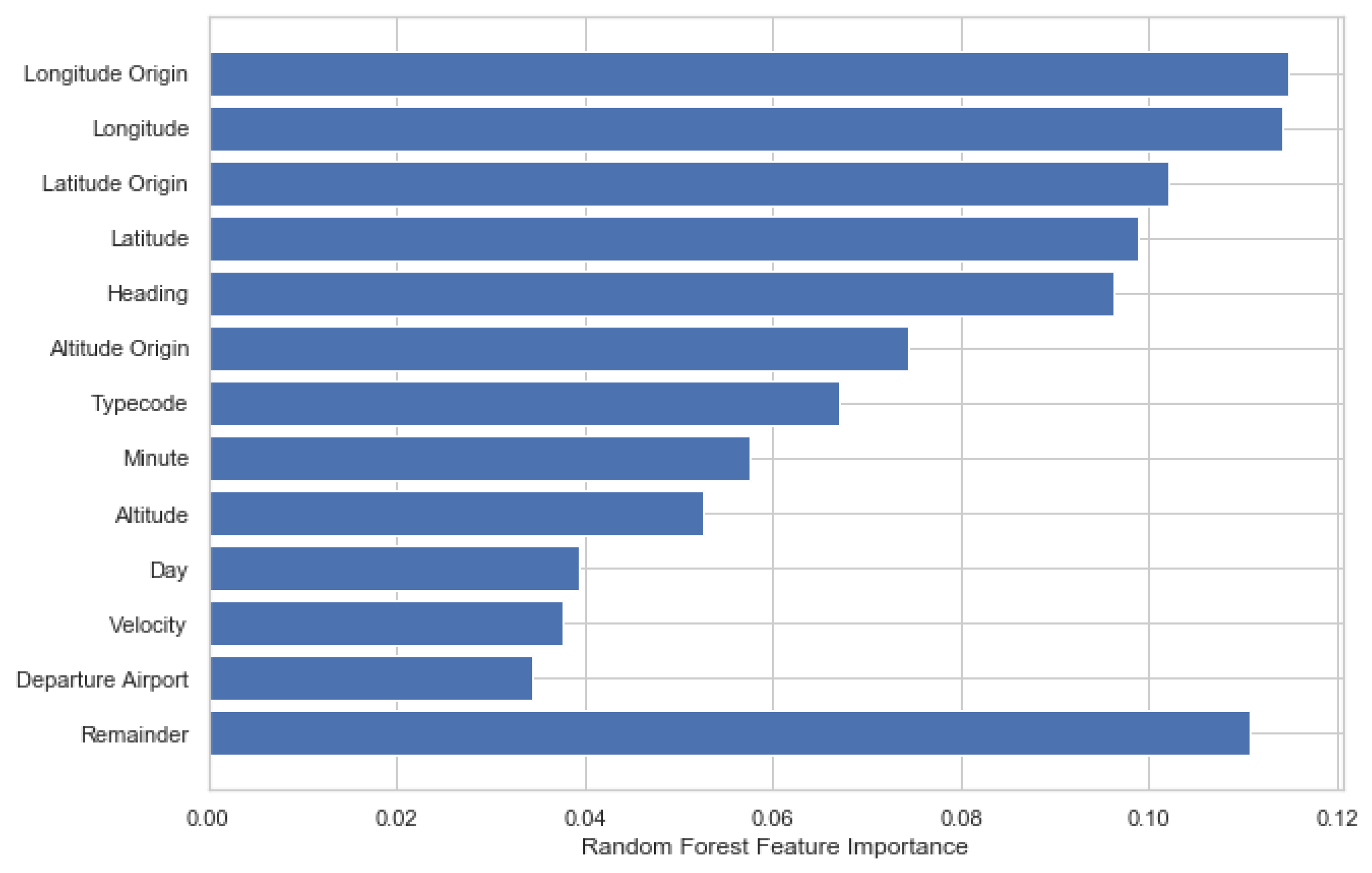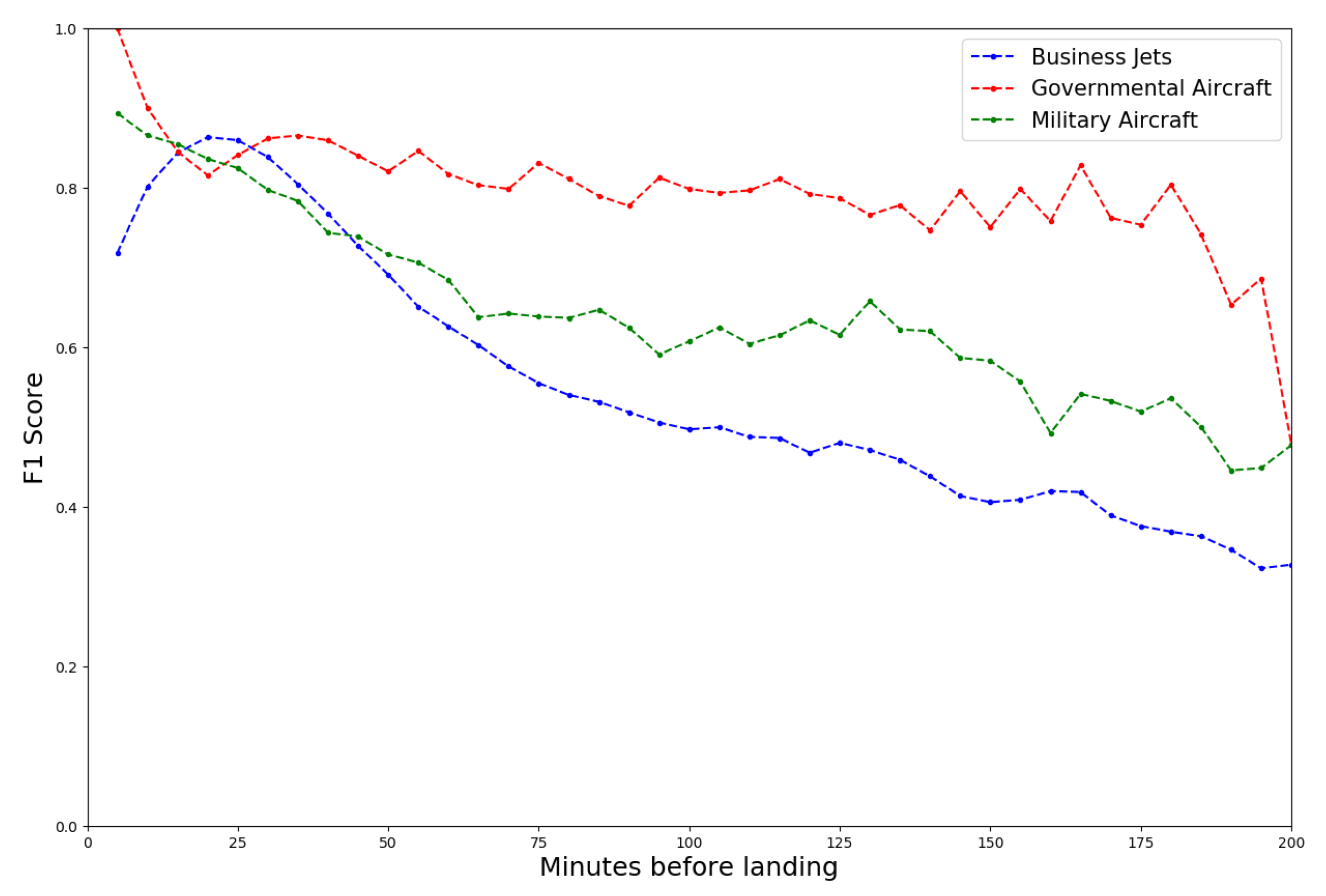I Know Where You Are Going: Predicting Flight Destinations of Corporate and State Aircraft †
Abstract
:1. Introduction
- Accurate prediction of a plane’s destination is possible up to 3 h before landing with a model suited for online prediction;
- Fine-grained estimation of the destination is possible with a manageable drop in accuracy for large number of clusters.
2. Related Work
3. The Aircraft Destination Prediction Problem
3.1. Usage Model
3.2. Research Questions
- How close to its landing can the rough destination of a special interest aircraft (corporate, government and military) be reliably predicted?
- At what granularity can the destination be predicted?
- What features or flight characteristics need to be captured in order to successfully predict the destination?
3.3. Challenges
- No ground truth labels: Solely using transponder data for aircraft that do not file a (public) flight plan means that no ground truth exists. We consider the ground truth to be the actual airport of departure and destination. Often times, the coverage area of the receivers does not reach below a certain altitude which means an aircraft is not tracked all the way to touchdown. We therefore had to devise a labeling scheme to generate training data.
- Granularity of destinations: Worldwide, there are thousands of airports, some of which are frequently used by all class of aircraft, others only in very rare instances. In order to predict the destination, a decision must be made which airports are considered viable destinations, or how to group airports together based on their usage and geographic location. This also allows us to vary the granularity of our approach.
- Destination representation: While the final objective is to predict the destination in terms of an airport (cluster), this could be represented internally as a regression problem with latitude and longitude as the dependent variables. In case the destination is represented as a classification task, depending on the granularity, the number of classes and the class imbalance can be very high. Both approaches allow us to explore slightly different pipelines in the modeling task.
4. Experimental Design
4.1. Data Sources
4.2. Data Pre-Processing
4.2.1. Non-Commercial Flights
4.2.2. Geographic Restriction
4.2.3. Data Cleaning
4.2.4. Airport Clustering
4.2.5. Labelling
4.2.6. Overall Statistics
4.3. Feature Engineering
4.4. Models
5. Evaluation
5.1. Time before Landing
5.2. Granularity of Destination
5.3. Type of Aircraft
6. Conclusions
Author Contributions
Funding
Data Availability Statement
Conflicts of Interest
References
- Schäfer, M.; Strohmeier, M.; Lenders, V.; Martinovic, I.; Wilhelm, M. Bringing up OpenSky: A large-scale ADS-B sensor network for research. In Proceedings of the 13th International Symposium on Information Processing in Sensor Networks (IPSN-14), Berlin, Germany, 15–17 April 2014; pp. 83–94. [Google Scholar]
- Strohmeier, M.; Smith, M.; Lenders, V.; Martinovic, I. The real first class? Inferring confidential corporate mergers and government relations from air traffic communication. In Proceedings of the 2018 IEEE European Symposium on Security and Privacy (EuroS&P), London, UK, 24–26 April 2018; pp. 107–121. [Google Scholar]
- Schäfer, M.; Strohmeier, M.; Smith, M.; Fuchs, M.; Lenders, V.; Liechti, M.; Martinovic, I. OpenSky report 2017: Mode S and ADS-B usage of military and other state aircraft. In Proceedings of the 2017 IEEE/AIAA 36th Digital Avionics Systems Conference (DASC), St. Petersburg, FL, USA, 17–21 September 2017; pp. 1–10. [Google Scholar]
- Bachmann, J. Hedge Funds Are Tracking Private Jets to Find the Next, Megadeal; Bloomberg: New York, NY, USA, 2019. [Google Scholar]
- Harrington, C.S.; Jonas, B.P.; Czerniakowski, F.; Clark, N.J. A Bayesian spatio-temporal aircraft route predictive algorithm with applications to military operations. In Artificial Intelligence and Machine Learning for Multi-Domain Operations Applications III; International Society for Optics and Photonics: Bellingham, WA, USA, 2021; Volume 11746, p. 117461B. [Google Scholar]
- Ayhan, S.; Samet, H. Aircraft trajectory prediction made easy with predictive analytics. In Proceedings of the 22nd ACM SIGKDD International Conference on Knowledge Discovery and Data Mining, San Francisco, CA, USA, 13–17 August 2016; pp. 21–30. [Google Scholar]
- Liu, Y.; Hansen, M. Predicting aircraft trajectories: A deep generative convolutional recurrent neural networks approach. arXiv 2018, arXiv:1812.11670. [Google Scholar]
- Shi, Z.; Xu, M.; Pan, Q.; Yan, B.; Zhang, H. LSTM-based flight trajectory prediction. Proceedings of 2018 International Joint Conference on Neural Networks (IJCNN), Rio de Janeiro, Brazil, 8–13 July 2018. [Google Scholar] [CrossRef] [Green Version]
- Martinez, V. Flight Delay Prediction. Master’s Thesis, ETH Zürich, Department of Computer Science, Zürich, Switzerland, 2012. [Google Scholar]
- Kim, Y.J.; Choi, S.; Briceno, S.; Mavris, D. A deep learning approach to flight delay prediction. In Proceedings of the 2016 IEEE/AIAA 35th Digital Avionics Systems Conference (DASC), Sacramento, CA, USA, 25–29 September 2016; pp. 1–6. [Google Scholar]
- Yu, B.; Guo, Z.; Asian, S.; Wang, H.; Chen, G. Flight delay prediction for commercial air transport: A deep learning approach. Transp. Res. Part Logist. Transp. Rev. 2019, 125, 203–221. [Google Scholar] [CrossRef]
- Sternberg, A.; Soares, J.; Carvalho, D.; Ogasawara, E. A review on flight delay prediction. arXiv 2017, arXiv:1703.06118. [Google Scholar]
- Hess, S.; Polak, J.W. Mixed logit modelling of airport choice in multi-airport regions. J. Air Transp. Manag. 2005, 11, 59–68. [Google Scholar] [CrossRef] [Green Version]
- Furuichi, M.; Koppelman, F.S. An analysis of air travelers’ departure airport and destination choice behavior. Transp. Res. Part Policy Pract. 1994, 28, 187–195. [Google Scholar] [CrossRef]
- Strohmeier, M.; Smith, M.; Moser, D.; Schäfer, M.; Lenders, V.; Martinovic, I. Utilizing air traffic communications for OSINT on state and government aircraft. In Proceedings of the 2018 10th International Conference on Cyber Conflict (CyCon), Tallinn, Estonia, 29 May–1 June 2018; pp. 299–320. [Google Scholar]
- Schäfer, M.; Strohmeicr, M.; Smith, M.; Fuchs, M.; Lenders, V.; Martinovic, I. OpenSky report 2018: Assessing the integrity of crowdsourced mode S and ADS-B data. In Proceedings of the 2018 IEEE/AIAA 37th Digital Avionics Systems Conference (DASC), London, UK, 23–27 September 2018; pp. 1–9. [Google Scholar]
- Strohmeier, M.; Olive, X.; Lübbe, J.; Schäfer, M.; Lenders, V. Crowdsourced air traffic data from the OpenSky Network 2019–2020. Earth Syst. Sci. Data 2021, 13, 357–366. [Google Scholar] [CrossRef]






Publisher’s Note: MDPI stays neutral with regard to jurisdictional claims in published maps and institutional affiliations. |
© 2021 by the authors. Licensee MDPI, Basel, Switzerland. This article is an open access article distributed under the terms and conditions of the Creative Commons Attribution (CC BY) license (https://creativecommons.org/licenses/by/4.0/).
Share and Cite
Jourdan, M.; Martinkus, K.; Roschewitz, D.; Strohmeier, M. I Know Where You Are Going: Predicting Flight Destinations of Corporate and State Aircraft. Eng. Proc. 2021, 13, 1. https://doi.org/10.3390/engproc2021013001
Jourdan M, Martinkus K, Roschewitz D, Strohmeier M. I Know Where You Are Going: Predicting Flight Destinations of Corporate and State Aircraft. Engineering Proceedings. 2021; 13(1):1. https://doi.org/10.3390/engproc2021013001
Chicago/Turabian StyleJourdan, Marc, Karolis Martinkus, David Roschewitz, and Martin Strohmeier. 2021. "I Know Where You Are Going: Predicting Flight Destinations of Corporate and State Aircraft" Engineering Proceedings 13, no. 1: 1. https://doi.org/10.3390/engproc2021013001
APA StyleJourdan, M., Martinkus, K., Roschewitz, D., & Strohmeier, M. (2021). I Know Where You Are Going: Predicting Flight Destinations of Corporate and State Aircraft. Engineering Proceedings, 13(1), 1. https://doi.org/10.3390/engproc2021013001





